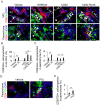Fluctuation of CD9/SOX2-positive cell populations during the turnover of GH- and TSH-producing cells in the adult anterior pituitary gland
- PMID: 37778977
- PMCID: PMC10721853
- DOI: 10.1262/jrd.2023-023
Fluctuation of CD9/SOX2-positive cell populations during the turnover of GH- and TSH-producing cells in the adult anterior pituitary gland
Abstract
The adenohypophysis is comprised of the anterior and intermediate lobes (AL and IL, respectively). Cluster of differentiation 9 (CD9)- and sex-determining region Y-box 2 (SOX2)-positive cells are stem/progenitor hormone-producing cells in the AL. They are located in the marginal cell layer (MCL) facing Rathke's cleft between the AL and IL (primary niche) and the parenchyma of the AL (secondary niche). We previously showed that, in rats, CD9/SOX2-positive cells in the IL side of the MCL (IL-side MCL) migrate to the AL side (AL-side MCL) and differentiate into prolactin-producing cells (PRL cells) in the AL parenchyma during pregnancy, lactation, and diethylstilbestrol treatment, all of which increase PRL cell turnover. This study examined the changes in CD9/SOX2-positive stem/progenitor cell niches and their proportions by manipulating the turnover of growth hormone (GH)- and thyroid-stimulating hormone (TSH)-producing cells (GH and TSH cells, respectively), which are Pit1 lineage cells, as well as PRL cells. After induction, the isolated CD9/SOX2-positive cells from the IL-side MCL formed spheres and differentiated into GH and TSH cells. We also observed an increased GH cell proportion upon treatment with GH-releasing hormone and recovery from continuous stress and an increased TSH cell proportion upon propylthiouracil treatment, concomitant with alterations in the proportion of CD9/SOX2-positive cells in the primary and secondary niches. These findings suggest that CD9/SOX2-positive cells have the potential to supply GH and TSH when an increase in GH and TSH cell populations is required in the adult pituitary gland.
Keywords: Cluster of differentiation 9 (CD9); Growth hormone (GH); Pituitary; Sex-determining region Y-box 2 (SOX2); Thyroid-stimulating hormone (TSH).
Conflict of interest statement
The authors have nothing to declare.
Figures






Similar articles
-
Differentiation of stem progenitor CD9/SOX2-positive cells is promoted with increased prolactin-producing and endothelial cells in the pituitary.J Reprod Dev. 2022 Aug 1;68(4):278-286. doi: 10.1262/jrd.2022-047. Epub 2022 Jun 11. J Reprod Dev. 2022. PMID: 35691820 Free PMC article.
-
CD9-positive cells in the intermediate lobe of the pituitary gland are important supplier for prolactin-producing cells in the anterior lobe.Cell Tissue Res. 2021 Sep;385(3):713-726. doi: 10.1007/s00441-021-03460-5. Epub 2021 May 7. Cell Tissue Res. 2021. PMID: 33961126
-
CD9-positive cells in the intermediate lobe migrate into the anterior lobe to supply endocrine cells.Histochem Cell Biol. 2021 Oct;156(4):301-313. doi: 10.1007/s00418-021-02009-5. Epub 2021 Jun 29. Histochem Cell Biol. 2021. PMID: 34185148
-
New insights into the role and origin of pituitary S100β-positive cells.Cell Tissue Res. 2021 Nov;386(2):227-237. doi: 10.1007/s00441-021-03523-7. Epub 2021 Sep 22. Cell Tissue Res. 2021. PMID: 34550453 Review.
-
Pleiomorphism plurihormonal Pit-1-positive macroadenoma with central hyperthyroidism: a rare case report and literature review.BMC Endocr Disord. 2022 Dec 21;22(1):325. doi: 10.1186/s12902-022-01220-2. BMC Endocr Disord. 2022. PMID: 36539773 Free PMC article. Review.
Cited by
-
Expression of Retinaldehyde Dehydrogenases in the Pituitary Glands of Fetus and Adult Mice.Acta Histochem Cytochem. 2024 Jun 28;57(3):109-118. doi: 10.1267/ahc.24-00018. Epub 2024 Jun 15. Acta Histochem Cytochem. 2024. PMID: 38988691 Free PMC article.
-
Three-dimensional cell culture using CD9-positive cells isolated from marginal cell layer of intermediate lobe of rats sustains in vivo-like primary niche environment.J Reprod Dev. 2024 Oct 1;70(5):343-347. doi: 10.1262/jrd.2024-033. Epub 2024 Aug 11. J Reprod Dev. 2024. PMID: 39135241 Free PMC article.
-
CD9/SOX2-positive cells in the intermediate lobe of the rat pituitary gland exhibit mesenchymal stem cell characteristics.Cell Tissue Res. 2025 Mar;399(3):277-290. doi: 10.1007/s00441-024-03947-x. Epub 2025 Jan 14. Cell Tissue Res. 2025. PMID: 39808267
References
-
- Kato Y, Yoshida S, Kato T. New insights into the role and origin of pituitary S100β-positive cells. Cell Tissue Res 2021; 386: 227–237. - PubMed
-
- Vila-Porcile E. The network of the folliculo-stellate cells and the follicles of the adenohypophysis in the rat (pars distalis). Z Zellforsch Mikrosk Anat 1972; 129: 328–369 (in French). - PubMed
-
- Horiguchi K, Fujiwara K, Takeda Y, Nakakura T, Tsukada T, Yoshida S, Hasegawa R, Takigami S, Ohsako S. CD9-positive cells in the intermediate lobe of the pituitary gland are important supplier for prolactin-producing cells in the anterior lobe. Cell Tissue Res 2021; 385: 713–726. - PubMed
MeSH terms
Substances
LinkOut - more resources
Full Text Sources
Molecular Biology Databases

